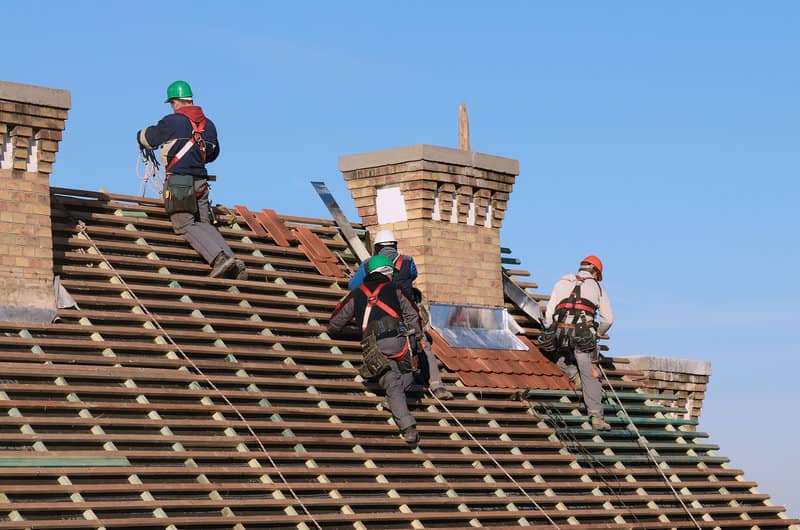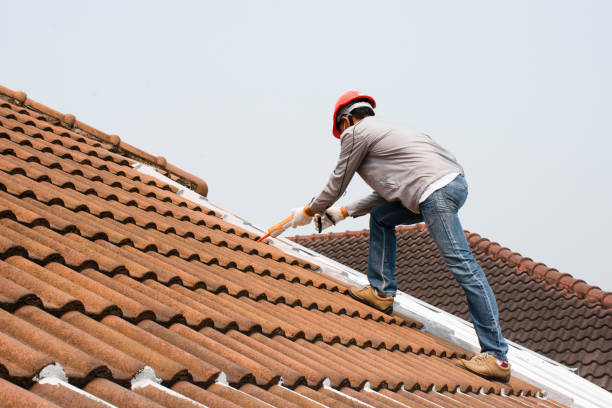A Comprehensive Overview to Different Roof Covering Types and Designs for Every Building
The option of roofing type is vital for any property. Each design offers distinct advantages, from aesthetic interest structural integrity. Gabled roofings exude timeless beauty, while level roofing systems offer a modern touch. Comprehending the nuances of various roof covering styles can greatly influence a home owner's choice. This guide gives insights right into each alternative, highlighting their distinct features and benefits. What might be the ideal choice for your residential or commercial property?
Gabled Roofs: Standard Appeal and Convenience
Different roof covering layouts exist, gabled roof coverings stand out for their classic appeal and versatility. Identified by their triangular form formed by two sloping sides, gabled roofs can be discovered in many architectural designs, from typical homes to contemporary homes. This design not just enhances the visual value of a building however also enhances air flow and water drainage, effectively shedding rain and snow.
Gabled roofs been available in various configurations, consisting of front gables, side gables, and go across gables, enabling house owners to select a style that matches their layout vision. In addition, they are relatively very easy to construct, which can lead to set you back savings throughout the building procedure. The adaptability of gabled roofing systems makes them appropriate for varied environments, as their steep slopes help prevent water build-up. In general, gabled roofing systems continue to be a preferred option for builders and property owners seeking a harmonious mix of functionality and ageless beauty.
Apartment Roofs: Modern Visual Appeals and Usefulness
While several property owners move in the direction of typical roof styles, level roofing systems supply a modern aesthetic and functional benefits that appeal to contemporary style. These roof coverings supply a streamlined, minimal appearance that enhances metropolitan atmospheres and modern-day designs. The straight airplane permits for versatile use area, making it possible for property owners to develop rooftop gardens, terraces, or added living locations.
Level roof coverings are also affordable, calling for less materials and much less labor throughout setup compared to angled roofs. Their simpleness can bring about reduced maintenance costs with time. Furthermore, level roofing systems promote very easy accessibility for upkeep and inspections, making them a functional option for industrial homes.

Hip Roofs: Security and Improved Water Drainage
Hip roofing systems, identified by their sloping sides that merge on top, provide both stability and enhanced drain for residential structures. This style reduces the danger of water pooling on the roof surface area, as the tilted inclines allow rainfall and snow to move off effectively. The in proportion nature of hip roofings additionally contributes to architectural honesty, distributing weight equally throughout all 4 sides, which is specifically beneficial in locations vulnerable to high winds or hefty snowfall.
In addition, hip roof coverings can use enhanced living room with the potential for vaulted ceilings or also attic room conversions. Their design can suit different roof covering products, permitting for aesthetic versatility (licensed roofing company lake tapps). On the whole, hip roofs are a sensible choice for homeowners looking for an equilibrium between functionality and style, guaranteeing strength against the aspects while enhancing the residential property's total visual allure
Mansard Roofs: Elegant Design With Bonus Living Area
Mansard roofing systems are defined by their distinct dual-pitched style, supplying a blend of style and performance. This building style not just boosts the aesthetic charm of a building yet also gives significant additional space within the upper degree. Home owners typically value the versatility and possibility for modification that mansard roofing systems existing.
Design Characteristics of Mansard
The unique shape of a mansard roof records focus with its elegant lines and dual inclines on each side. This architectural design includes a steep reduced incline that usually includes dormer home windows, creating a striking visual impact. The upper slope, which is much less high, is slightly sloped or normally level, enabling a special profile that enhances the total aesthetic of the structure. Mansard roofings are typically defined by their use of various products, including metal, slate, or tile, providing adaptability in style. The design enables enhanced clearance in the upper floor, making it ideal for different building styles, from timeless to modern. On the whole, the mansard roofing exhibits a blend of capability and advanced layout.
Benefits of Extra Room
Many house owners appreciate the one-of-a-kind advantage that mansard roofings offer in optimizing useful area within a structure. This architectural design includes a double-pitched roofing system, giving added headroom and the capacity for added living areas such as rooms, workplaces, or leisure rooms. The top degree can be conveniently transformed into practical spaces, enhancing property worth and convenience. Furthermore, the design enables for larger windows and raised all-natural light, creating an inviting atmosphere. Mansard roof coverings additionally enable home owners to maintain a typical visual while enjoying modern-day benefits, making them particularly appealing for those looking for a blend of sophistication and functionality. Overall, these roofings deliver both style and performance, making them a popular option for numerous homes.
Dropped Roofs: Minimal Style and Performance
While some may ignore their simpleness, lost roofs use an one-of-a-kind mix of minimal design and practical efficiency. Identified by a solitary sloping surface area, these roofing systems are both uncomplicated and visually pleasing, making them a prominent option for modern-day architecture. The clean lines of a shed roof add to a contemporary appearance, frequently matching numerous structure designs.
Along with their visual appeal, shed roofs are extremely effective. Their incline permits effective rainwater drainage, reducing the risk of leaks and water buildup. This layout likewise promotes the installment of skylights, improving all-natural light within the space. Moreover, lost roofs are economical, as they call for fewer materials and labor compared to more complex roof.
Dome Roofs: Special Architecture and Power Performance
Dome roofings provide a distinctive building style that sets them apart from traditional roof covering styles, boosting the visual charm of any framework. In addition to their aesthetic originality, these roofs are recognized for their energy efficiency, as their form advertises all-natural air flow and decreases warmth build-up. The construction of dome roofs offers certain structural difficulties that should be meticulously thought about throughout the design stage.
Architectural Looks and Appeal
The allure of dome roofings lies in their unique building design, which effortlessly blends visual appeal with useful benefits. These roofings produce a striking visual influence, often acting as the focal factor of various frameworks. Their curved form evokes a sense of style, enabling innovative expression in both commercial and property buildings. Dome roof coverings can harmonize with diverse architectural designs, from typical to modern-day, boosting total property worth. The sizable indoor produced by the dome form permits ingenious layout possibilities, fostering a welcoming ambience. In addition, the one-of-a-kind shape of dome roofings makes them a popular option for cultural and public structures, representing unity and security while bewitching the creativity of observers.
Power Performance Perks
Innovative architectural attributes usually include added useful benefits, and dome roofs exemplify this by boosting energy effectiveness. The rounded shape of dome roofs permits optimal air blood circulation, minimizing the reliance on home heating and cooling down systems. This design decreases surface exposed to external components, resulting in lower energy loss contrasted to traditional flat or angled roofs. Dome roofings can efficiently accommodate insulation products, further boosting thermal performance. Their ability to mirror sunshine can likewise minimize warm absorption, keeping insides why not find out more cooler throughout warm months. In addition, the architectural honesty of dome roofing systems permits making use of lasting materials, making them a green choice. Generally, dome roof coverings give an unique combination of visual appeal and energy-saving advantages for building owners.
Structural Factors To Consider and Challenges
While dome roofings supply numerous energy effectiveness advantages, they additionally present distinct architectural factors to consider and obstacles that must be attended to throughout style and construction. The curvature of dome roofing systems needs cautious engineering to disperse weight equally, which can make complex the architectural structure. Furthermore, products need to be picked for their capacity to withstand diverse climate problems, consisting of wind uplift and snow lots. The construction process may demand specialized techniques and competent labor to guarantee appropriate assembly, frequently increasing job expenses. Incorporating pipes, electrical systems, and insulation into the curved surface area can posture additional obstacles. In general, an extensive understanding of these variables is crucial for attaining the wanted functional and aesthetic end results in dome roofing system styles.
Regularly Asked Inquiries
Exactly How Do Roofing System Types Affect Home Insurance Coverage Premiums?
Roofing system kinds significantly influence home insurance coverage premiums, as insurance providers assess threat variables like durability, fire resistance, and climate performance. roofing contractor lake tapps wa. Homes with tougher roofing systems often enjoy lower costs, while less reliable products may bring about higher costs
What Materials Are Ideal for Each Roof Covering Type?
Usual roofing products include asphalt shingles for sloped roofing systems, steel for longevity, clay tiles for visual appeals, and slate for long life. Each material uses distinct advantages, affecting elements like insulation, upkeep, and overall strength.
Just How Does Climate Impact Roofing System Style Selections?
Climate considerably influences roofing layout options, as regions with heavy snowfall call for steep inclines for useful link water drainage, while areas with high temperatures may benefit from materials that reflect warm. Moisture additionally dictates ventilation needs and material longevity.

Can I Change My Roof Kind Later?
Yes, altering a roofing type later on is feasible, but it involves careful consideration of architectural stability, neighborhood policies, and price. Home owners must seek advice from experts to guarantee appropriate execution and conformity with structure codes.
What Is the Average Life Expectancy of Different Roof Coverings?
The average lifespan of roofing systems differs: asphalt tiles last 15-30 years, steel roof coverings can endure 40-70 years, while tile and slate roofings may last approximately 100 years, relying on upkeep and environmental aspects.
Gabled roofings radiate traditional beauty, while flat roofings provide a contemporary touch. Numerous roof covering layouts exist, gabled roofing systems stand out for their timeless charm and convenience. While lots of home owners are attracted in the direction of conventional roofing system styles, flat roof coverings provide a modern visual and functional advantages that appeal to contemporary design. Level roofing systems are browse this site additionally cost-effective, calling for less products and much less labor during installment contrasted to pitched roofings. Dome roofings offer a distinctive building design that sets them apart from traditional roof covering designs, boosting the aesthetic charm of any kind of structure.